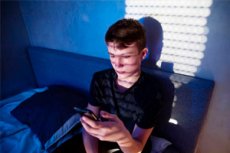Smartphone light affects puberty
Last reviewed: 07.06.2024

All iLive content is medically reviewed or fact checked to ensure as much factual accuracy as possible.
We have strict sourcing guidelines and only link to reputable media sites, academic research institutions and, whenever possible, medically peer reviewed studies. Note that the numbers in parentheses ([1], [2], etc.) are clickable links to these studies.
If you feel that any of our content is inaccurate, out-of-date, or otherwise questionable, please select it and press Ctrl + Enter.

Blue light coming from the screens of smartphones and other similar gadgets stimulates early puberty in rodents. This information was announced during the 61st regular congress of the European Society of Pediatric Endocrinologists, which was held in The Hague in early fall.
Nowadays, smartphones, tablets and laptops have become a part of our lives, and they are actively used by almost everyone - from children to the elderly. The screens of gadgets emit high-energy short-wave blue light. If you use a smartphone in the dark, it leads to inhibition of the synthesis of melatonin - the so-called stress factor that activates tissue oxidation processes.
The period of puberty combines diverse and strong hormonal, physiological, behavioral changes, which together lead to the formation of reproductive capabilities. At what age this occurs depends on many factors, such as nutritional status, general health, environmental conditions, stress history and so on. Over the past decade, several studies have been conducted on the possible causes of accelerated puberty in children. One of them was to study the effects of blue light emitting devices.
Employees of the Turkish city hospital of Ankara Bilkent and Gazi University involved in the study eighteen male rodents, the age of which was 21 days. The animals were conditionally divided into two groups. The first group led a normal lifestyle, representatives of the second group daily for 6 hours exposed to blue light, and the third group was exposed to such an impact for 12 hours a day. Specialists found that the first symptoms of the onset of puberty formed much earlier in male rodents that were under the influence of blue light. In addition, the more time the animals spent under the light, the earlier they started puberty. It is noteworthy that spermatogenesis was simultaneously inhibited, the vessels of testes were intensively dilated, and the basal membrane was damaged.
The same team of specialists had already conducted a study on female rats. The results were almost the same as in males. Thus, we can confidently say that there is a relationship between the influence of blue light and the onset of early puberty in rodents. Whether these results can be applied to humans is still unknown. However, the experiment gives serious cause for reflection. In any case, the researchers have already set the basis for further study of the adverse effects on humans from the use of gadgets.
Details about this study are provided on pagetitle="Frontiers | Is blue light exposure a cause of precocious puberty in male rats?">
